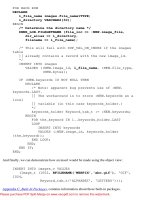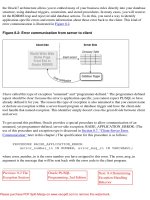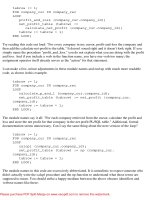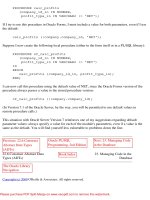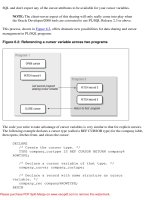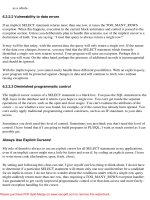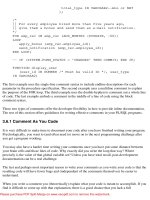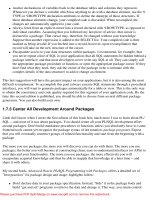Oracle PL/SQL Language Pocket Reference- P5
Bạn đang xem bản rút gọn của tài liệu. Xem và tải ngay bản đầy đủ của tài liệu tại đây (202.35 KB, 50 trang )
the Oracle7 architecture allows you to embed many of your business rules directly into your database
structure, using database triggers, constraints, and stored procedures. In many cases, you will want to
let the RDBMS trap and reject invalid database actions. To do this, you need a way to identify
application-specific errors and return information about those error back to the client. This kind of
error communication is illustrated in Figure 8.2.
Figure 8.2: Error communication from server to client
I have called this type of exception "unnamed" and "programmer-defined." The programmer-defined
aspect should be clear: because the error is application-specific, you cannot expect PL/SQL to have
already defined it for you. The reason this type of exception is also unnamed is that you cannot name
or declare an exception within a server-based program or database trigger and have the client-side
tool handle that named exception. This identifier simply doesn't cross the great divide between client
and server.
To get around this problem, Oracle provides a special procedure to allow communication of an
unnamed, yet programmer-defined, server-side exception: RAISE_APPLICATION_ERROR. (The
use of this procedure and exception type is discussed in
Section 8.7, "Client-Server Error
Communication" later in this chapter.) The specification for this procedure is as follows:
PROCEDURE RAISE_APPLICATION_ERROR
(error_number_in IN NUMBER, error_msg_in IN VARCHAR2);
where error_number_in is the error number you have assigned to this error. The error_msg_in
argument is the message that will be sent back with the error code to the client program.
Previous: 8.2 The
Exception Section
Oracle PL/SQL
Programming, 2nd Edition
Next: 8.4 Determining
Exception-Handling
Behavior
Please purchase PDF Split-Merge on www.verypdf.com to remove this watermark.
8.2 The Exception Section
Book Index
8.4 Determining Exception-
Handling Behavior
The Oracle Library
Navigation
Copyright (c) 2000 O'Reilly & Associates. All rights reserved.
Please purchase PDF Split-Merge on www.verypdf.com to remove this watermark.
Previous: 8.1 Why
Exception Handling?
Chapter 8
Exception Handlers
Next: 8.3 Types of
Exceptions
8.2 The Exception Section
A PL/SQL block (of which procedures, functions, and anonymous blocks are all instances) consists
of up to four parts: the header, declaration section, execution section, and exception section, as shown
in the following anonymous block:
DECLARE
... declarations ...
BEGIN
... executable statements ...
[ EXCEPTION
... exception handlers ... ]
END;
When an exception is raised within the execution section of a PL/SQL block, control passes to the
exception section. PL/SQL then scans through the exception handlers to see if that exception is
handled.
The syntax for an exception section follows:
EXCEPTION
WHEN exception_name [ OR exception_name ... ]
THEN
<executable statements>
END;
You can have multiple exception handlers in a single exception section. The exception handlers are
structured much like a conditional CASE statement, as shown below:
The Exception Section An English-like Translation
Please purchase PDF Split-Merge on www.verypdf.com to remove this watermark.
EXCEPTION
WHEN NO_DATA_FOUND
THEN
executable_statements1;
If the NO_DATA_FOUND exception
was raised, then execute the first set of
statements.
WHEN payment_overdue
THEN
executable_statements2;
If the payment is overdue, then execute
the second set of statements.
WHEN OTHERS
THEN
executable_statements3;
END;
If any other exception is encountered,
then execute the third set of statements.
An exception is handled if an exception that is named in a WHEN clause matches the exception that
was raised. Notice that the WHEN clause traps errors only by exception name, not by error codes. If a
match is found, then the executable statements associated with that exception are run. If the exception
that has been raised is not handled or does not match any of the named exceptions, the executable
statements associated with the WHEN OTHERS clause -- if present -- will be run.
The WHEN OTHERS clause is optional; if it is not present, then any unhandled exception is
immediately raised in the enclosing block, if any.
If the exception is not handled by any PL/SQL block, then the error number and message are
presented directly to the user of the application. The exception is, in other words, unhandled and it
disrupts the execution of the application.
Previous: 8.1 Why
Exception Handling?
Oracle PL/SQL
Programming, 2nd Edition
Next: 8.3 Types of
Exceptions
8.1 Why Exception Handling?
Book Index
8.3 Types of Exceptions
The Oracle Library
Navigation
Copyright (c) 2000 O'Reilly & Associates. All rights reserved.
Please purchase PDF Split-Merge on www.verypdf.com to remove this watermark.
Previous: 7.7 Tips for PL/
SQL Loops
Chapter 8
Next: 8.2 The Exception
Section
8. Exception Handlers
Contents:
Why Exception Handling?
The Exception Section
Types of Exceptions
Determining Exception-Handling Behavior
Raising an Exception
Handling Exceptions
Client-Server Error Communication
NO_DATA_FOUND: Multipurpose Exception
Exception Handler as IF Statement
RAISE Nothing but Exceptions
In the PL/SQL language, errors of any kind are treated as exceptions -- situations that should not
occur -- in your program. An exception can be one of the following:
●
An error generated by the system (such as "out of memory" or "duplicate value in index")
●
An error caused by a user action
●
A warning issued by the application to the user
PL/SQL traps and responds to errors using an architecture of exception handlers. The exception-
handler mechanism allows you to cleanly separate your error processing code from your executable
statements. It also provides an event-driven model, as opposed to a linear code model, for processing
errors. In other words, no matter how a particular exception is raised, it is handled by the same
exception handler in the exception section.
When an error occurs in PL/SQL, whether a system error or an application error, an exception is
raised. The processing in the current PL/SQL block's execution section halts and control is transferred
to the separate exception section of your program, if one exists, to handle the exception. You cannot
return to that block after you finish handling the exception. Instead, control is passed to the enclosing
block, if any.
Please purchase PDF Split-Merge on www.verypdf.com to remove this watermark.
Figure 8.1 illustrates how control is transferred to the exception section when an exception is raised.
Figure 8.1: Exception handling architecture
8.1 Why Exception Handling?
It is a sad fact of life that most programmers never take the time to properly bullet-proof their
programs. Instead, wishful thinking often reigns. Most of us find it hard enough -- and more than
enough work -- to simply write the code that implements the positive aspects of an application:
maintaining customers, generating invoices, etc. It is devilishly difficult from both a psychological
standpoint and a resources perspective to focus on the negative side of our life: what happens when
the user presses the wrong key? If the database is unavailable, what should I do?
As a result, we write applications that often assume the best of all possible worlds, hoping that our
programs are bug-free, that users will enter only the correct data in only the correct fashion, and that
all systems (hardware and software) will always be a "go."
Of course, harsh reality dictates that no matter how hard you try, there will always be one more bug
in your application. And your users will always find just the right sequence of keystrokes it takes to
make a screen implode. The situation is clear: either you spend the time up front to properly debug
and bulletproof your programs, or you will fight an unending series of rear-guard battles, taking
frantic calls from your users and putting out the fires.
You know what you should do. Fortunately, PL/SQL offers a powerful and flexible way to trap and
handle errors in your programs. It is entirely feasible within the PL/SQL language to build an
application which fully protects the user and the database from errors.
Please purchase PDF Split-Merge on www.verypdf.com to remove this watermark.
The exception handler model offers the following advantages:
●
Event-driven handling of errors. As we've mentioned, PL/SQL exception handling follows an
event-driven rather than a linear code model. No matter how a particular exception is raised, it
is handled by the same exception handler in the exception section. You do not have to check
repeatedly for a condition in your code, but instead can insert an exception for that condition
once in the exception section and be certain that it will be handled throughout that block (and
all of its enclosing blocks).
●
Clean separation of error-processing code. With the exception-handling model, whenever an
exception is raised, program control transfers completely out of the normal execution
sequence and into the exception section. Instead of placing error-handling logic throughout
different sections of your program, you can consolidate all of this logic into a single, separate
section. Furthermore, if you need to add new exceptions in your program (perhaps you
overlooked a possible problem, or a new kind of system error has been identified), you do not
have to figure out where in your executable code to put the error-handling logic. Simply add
another exception handler at the bottom of the block.
●
Improved reliability of error handling. It is quite difficult for errors to go undetected with the
PL/SQL error-handling model. If there is a handler, then that exception will be dealt with in
the current block or in an enclosing block. Even if there is no explicit handler for that error,
normal code execution will still stop. Your program cannot simply "work through" an error --
unless you explicitly organize your code to allow this.
There is no avoiding the fact that if you want to trap errors in your PL/SQL programs you will have
to write some additional code. The exception handler architecture, however, minimizes the amount of
code you will need to write, and offers the possibility of guarding against all problems that might
arise in your application. The following sections look at how you define, raise, and handle exceptions
in PL/SQL.
Previous: 7.7 Tips for PL/
SQL Loops
Oracle PL/SQL
Programming, 2nd Edition
Next: 8.2 The Exception
Section
7.7 Tips for PL/SQL Loops
Book Index
8.2 The Exception Section
The Oracle Library
Navigation
Copyright (c) 2000 O'Reilly & Associates. All rights reserved.
Please purchase PDF Split-Merge on www.verypdf.com to remove this watermark.
Previous: 7.6 Managing
Loop Execution
Chapter 7
Loops
Next: 8. Exception Handlers
7.7 Tips for PL/SQL Loops
Loops are very powerful and useful constructs, but they are among the most complicated control
structures in PL/SQL. The tips in this section will help you select the most efficient and easily
maintained loops for your programs.
7.7.1 Naming Loop Indexes
How would you like to try to understand -- much less maintain -- code that looks like this?
FOR i IN start_id .. end_id
LOOP
FOR j IN 1 .. 7
LOOP
FOR k IN 1 .. 24
LOOP
build_schedule (i, j, k);
END LOOP;
END LOOP;
END LOOP;
It is hard to imagine that someone would write code based on such generic integer variable names
(right out of Algebra 101), yet it happens all the time. The habits we pick up in our earliest days of
programming have an incredible half-life. Unless you are constantly vigilant, you will find yourself
writing the most abominable code. In this case, the solution is simple: use variable names for the loop
indexes that are meaningful and therefore self-documenting:
FOR focus_account IN start_id .. end_id
LOOP
FOR day_in_week IN 1 .. 7
LOOP
FOR month_in_biyear IN 1 .. 24
LOOP
build_schedule (focus_account, day_in_week,
Please purchase PDF Split-Merge on www.verypdf.com to remove this watermark.
month_in_biyear);
END LOOP;
END LOOP;
END LOOP;
Well, that cleared things up! Before I substituted the meaningless loop index names, I would wager
that you were fairly sure the statement:
FOR j IN 1 .. 7
meant that "j" stood for the seven days of the week. And I bet further that you were equally confident
that:
FOR k IN 1 .. 24
meant that "k" represented the hours in a day.
Now that I have provided descriptive names for those index variables, however, you discover that the
innermost loop actually spanned two sets of twelve months (12 × 2 = 24). Your deduction about "k",
while reasonable, was wrong, but it would have been completely impossible to determine this without
looking at the build_schedule code. Given PL/SQL's ability to hide information within packages, this
code might not even be available.
Software programmers should not have to make Sherlock Holmes-like deductions about the meaning
of the start and end range values of the innermost FOR loops in order to understand their purpose.
Use names that self-document the purposes of variables and loops. That way other people will
understand your code and you will remember what your own code does when you review it three
months later.
7.7.2 The Proper Way to Say Goodbye
No matter what kind of loop you are using, there is always only one entry point into the loop: the first
executable statement following the LOOP keyword. Your loops should also have just one way of
leaving the loop. The method of exit, furthermore, should be compatible with the type of loop you
use. The following tips will help you write well-structured and easily maintained loops.
7.7.2.1 Premature FOR loop termination
The syntax of the FOR loop states your intent explicitly and should only be a FOR loop if you know
in advance how many times the loop needs to execute. For example, the following loop is very clear:
FOR month_count IN 1 .. 12
LOOP
analyze_month (month_count);
Please purchase PDF Split-Merge on www.verypdf.com to remove this watermark.
END LOOP;
It states: "I am going to execute the analyze_month procedure 12 times, once for each month in the
year." Straightforward and easy to understand.
Now take a look at the next numeric FOR loop:
FOR year_count IN 1 .. years_displayed
LOOP
IF year_count > 10 AND :store.status = 'CLOSED'
THEN
EXIT;
END IF;
analyze_month (month_count);
END LOOP;
In this case, the loop boundary states: "Run the loop for the number of years displayed in the form."
Yet in the body of the loop, an IF statement allows a premature termination of the loop. If the year
count (the loop index) exceeds 10 and the current store status is CLOSED, then an EXIT statement is
issued and the loop halts.
This approach is very unstructured and contradictory. The loop boundary states one thing, but the
loop body executes something very different.
You should always let a FOR loop (whether numeric or cursor) complete its stated number of
iterations. If you do need to conditionally halt loop execution, you should choose either an infinite or
a WHILE loop. The above FOR loop could, for example, be easily recoded as follows:
FOR year_count IN 1 .. LEAST (years_displayed, 11)
LOOP
analyze_month (month_count);
END LOOP;
Similar guidelines apply to the infinite and WHILE loop, as I explore in the next sections.
7.7.2.2 EXIT and EXIT WHEN statements
Neither the FOR loop nor the WHILE loop should use the EXIT and EXIT WHEN statements. You
have already seen why this is so in FOR loops. Consider the following WHILE loop:
WHILE more_records
LOOP
NEXT_RECORD;
EXIT WHEN :caller.name IS NULL;
END LOOP;
Please purchase PDF Split-Merge on www.verypdf.com to remove this watermark.
In this case, even though my loop boundary indicates that the body should execute until
more_records evaluates to FALSE, the EXIT WHEN in the loop body bypasses that condition.
Instead of using EXITs in your WHILE loop, you should always rely exclusively on your loop
condition to determine whether the looping should continue. The previous WHILE loop can be
redesigned as follows:
WHILE more_records
LOOP
NEXT_RECORD;
more_records := :caller.name IS NOT NULL;
END LOOP;
7.7.2.3 RETURN statement
The RETURN statement will cause instant termination of a function and return the specified value
back to the calling program. Never use a RETURN statement inside a loop.
Unfortunately, such things have been known to happen. In the following example of terrifically poor
programming practice (taken from an Oracle Corporation reference manual, I am sorry to say), the
FOR loop is interrupted -- not with an EXIT, which would be unstructured enough, but with a
RETURN statement:
BEGIN
the_rowcount := Get_Group_Row_Count( rg_id );
FOR j IN 1..the_rowcount
LOOP
col_val := Get_Group_Char_Cell( gc_id, j );
IF UPPER(col_val) = UPPER(the_value)
THEN
RETURN j;
END IF;
END LOOP;
END;
The author of this program was in a big hurry to return to the calling program!
Once again, if the loop should be conditionally terminated, do not use a FOR loop. Instead, use a
WHILE or infinite loop and then issue the RETURN after the loop is completed. The following code
replaces the unstructured IF statement shown above:
Please purchase PDF Split-Merge on www.verypdf.com to remove this watermark.
BEGIN
/* Initialize the loop boundary variables. */
row_index := 0;
the_rowcount := Get_Group_Row_Count (rg_id);
/* Use a WHILE loop. */
WHILE row_index <= the_rowcount AND
match_not_found
LOOP
row_index := row_index + 1;
col_val := Get_Group_Char_Cell (gc_id,
row_index);
match_not_found := UPPER (col_val) != UPPER
(the_value)
END LOOP;
/* Now issue the RETURN statement. */
RETURN row_index;
END;
7.7.2.4 GOTO statements inside a loop
The same reasons for avoiding a RETURN apply to the GOTO statement. If you use a GOTO to exit
from a loop, you bypass the logical structure of the loop. You end up with code that is very difficult
to trace, debug, fix, and maintain.
7.7.3 Avoiding the Phony Loop
As I have stated previously, you should not use a numeric FOR loop if you cannot specify in a range
scheme of lowest and highest bounds the number of times the loop must execute. Just because you
know the number of iterations of some code, however, doesn't mean that you should use a loop.
I have run across a number of programs which execute variations on this kind of FOR loop:
FOR i IN 1 .. 2
LOOP
IF i = 1
THEN
give_bonus (president_id, 2000000);
ELSIF i = 2
THEN
give_bonus (ceo_id, 5000000);
END IF;
END LOOP;
Please purchase PDF Split-Merge on www.verypdf.com to remove this watermark.
This loop provides hefty bonuses to the president and CEO of a company that just went deep into
debt to acquire a competitor. I need to use the loop so the code executes twice to make sure both the
president and CEO receive their just compensation. Right? Wrong. This code should not be inside a
loop. It does not need iteration to perform its job; the LOOP syntax just confuses the issue.
The two sections within the IF-THEN-ELSE construct in the previous example both need to be
executed all the time; this is straight sequential code and should be written as follows:
give_bonus (president_id, 2000000);
give_bonus (ceo_id, 5000000);
7.7.4 PL/SQL Loops Versus SQL Processing
One of the indicators that a numeric FOR loop is being used incorrectly is that the loop index is not
used for anything but traffic control inside the loop. The actual body of executable statements
completely ignores the loop index. When that is the case, there is a good chance that you don't need
the loop at all.
When should you use standard SQL to accomplish your task and when should you rely on PL/SQL
loops? Sometimes the choice is clear: if you do not need to interact with the database, then there is
clearly no need for SQL. In addition, SQL can't always provide the necessary flexibility to get the job
done. Conversely, if you are performing a single record insert into a table then there is no need for a
loop. Often, however, the choice is less obvious. For example, a SELECT statement queries one or
more rows from the database. A cursor FOR loop also queries rows from the database based on a
SELECT statement. In fact, PL/SQL and native SQL often can both accomplish the task at hand.
Given that fact, you will need to choose your implementation according to more subtle issues like
performance and maintainability of code.
Before we look at some examples of scenarios which call for one or the other approach, let's review
the difference between the implicit looping of the SQL set-at-a-time approach and the PL/SQL loop.
SQL statements such as SELECT, UPDATE, INSERT, and DELETE work on a set of data. That set
(actually, a collection of rows from a table or tables) is determined by the WHERE clause (or lack
thereof) in the SQL statement. SQL derives much of its power and effectiveness as a database
language from this set-at-a-time processing approach. There is, however, a drawback, as I mentioned
earlier: SQL often does not give you the flexibility you might need to handle individual records and
specialized logic which must be applied differently to different records.
The PL/SQL cursor offers the ability to access a record at a time and to take action based on the
contents of that specific record. It is not always clear, however, which language component would
best fit the needs of the moment. I have seen a number of programs where developers went overboard
in their drive to PL/SQL-ize the SQL access to their data. This happens most frequently when using a
cursor FOR loop.
Please purchase PDF Split-Merge on www.verypdf.com to remove this watermark.
The PL/SQL block in the code below moves checked-out pets from the pet hotel occupancy table to
the pets_history table using a cursor FOR loop. For each record fetched (implicitly) from the cursor
(representing a pet who has hit the road), the body of the loop first inserts a record into the
pet_history table and then deletes the record from the occupancy table:
DECLARE
CURSOR checked_out_cur IS
SELECT pet_id, name, checkout_date
FROM occupancy
S checkout_date IS NOT NULL;
BEGIN
FOR checked_out_rec IN checked_out_cur
LOOP
INSERT INTO occupancy_history (pet_id, name,
checkout_date)
VALUES (checked_out_rec.pet_id, checked_out_rec.
name,
checked_out_rec.checkout_date);
DELETE FROM occupancy WHERE pet_id =
checked_out_rec.pet_id;
END LOOP;
END;
This will work just fine. But do we really need to use a cursor FOR loop to accomplish this task?
Suppose 20 animals checked out today. This block of code will then perform 20 distinct inserts and
20 distinct deletes. The same code can be written completely within the SQL language as shown
below:
INSERT INTO occupancy_history (pet_id, name,
checkout_date)
SELECT pet_id, name, checkout_date
FROM occupancy
WHERE checkout_date IS NOT NULL;
DELETE FROM occupancy WHERE checkout_date IS NOT NULL;
Here, a single insert (making use of the INSERT...SELECT syntax) and a single delete (which now
checks for the checkout_date and not the employee_id) accomplish the transfer of the data to the
history table. This reliance on native SQL, without the help of PL/SQL, allows you to take full
advantage of array processing. It significantly reduces network traffic in a client-server environment
because only two SQL statements (instead of 40) are passed to the RDBMS.
The cursor FOR loop was not really needed here; the body of the loop did not perform any procedural
logic which could not be handled by SQL itself. If, on the other hand, the program needed to
selectively reject records for the transfer, or otherwise perform procedural logic not possible within
SQL, then either the cursor FOR loop or a WHILE loop would make sense.
Please purchase PDF Split-Merge on www.verypdf.com to remove this watermark.
Previous: 7.6 Managing
Loop Execution
Oracle PL/SQL
Programming, 2nd Edition
Next: 8. Exception Handlers
7.6 Managing Loop Execution
Book Index
8. Exception Handlers
The Oracle Library
Navigation
Copyright (c) 2000 O'Reilly & Associates. All rights reserved.
Please purchase PDF Split-Merge on www.verypdf.com to remove this watermark.
Previous: 7.5 The WHILE
Loop
Chapter 7
Loops
Next: 7.7 Tips for PL/SQL
Loops
7.6 Managing Loop Execution
I've explained how to construct the different kinds of PL/SQL loops. The topics in this section
address the following nuances of loop execution:
Labels
You can associate a label with a loop and use that label to increase your control over loop
execution.
Scope
The loop boundary creates a scope similar to that of a PL/SQL block.
Termination
There is only one way to enter a loop, but a number of ways you can exit your loop.
7.6.1 Loop Labels
You can associate a name with a loop by using a label. A loop label in PL/SQL has the following
format:
<<label_name>>
where label_name is the name of the label. (By the way, this is the same format used for GOTO
labels.) In order to associate a name with a loop, however, the loop label must appear just before the
LOOP statement as shown below:
<<all_emps>>
FOR emp_rec IN emp_cur
LOOP
...
END LOOP;
Please purchase PDF Split-Merge on www.verypdf.com to remove this watermark.
The label can also appear optionally after the END LOOP reserved words, as the following example
demonstrates:
<<year_loop>>
WHILE year_number <= 1995
LOOP
<<month_loop>>
FOR month_number IN 1 .. 12
LOOP
...
END LOOP month_loop;
END LOOP year_loop;
By providing a label for a loop, you give that loop a name. This allows you to use dot notation to
refer to loop-related variables, such as the FOR loop index. In the following example of nested FOR
loops, I qualify my reference to the year_number index with the loop name:
<<year_loop>>
WHILE year_number <= 1995
LOOP
<<month_loop>>
FOR month_number IN 1 .. 12
LOOP
IF year_loop.year_number = 1900
THEN
...
END IF;
END LOOP month_loop;
END LOOP year_loop;
7.6.1.1 Benefits of loop labels
The loop label is useful in two particular situations:
●
When you have written a loop whose code length exceeds a single page, use a loop label to tie
the end of the loop back explicitly to its start. This visual tag will make it easier for a
developer to maintain and debug the program. Without the loop label, it can be very difficult
to keep track of which LOOP goes with which END LOOP.
●
When you have nested loops, you can use the label to both improve readability and increase
control over the execution of your loops. This capability is explored in the next section.
Please purchase PDF Split-Merge on www.verypdf.com to remove this watermark.
7.6.1.2 Loop termination using labels
You can affect loop execution by adding a loop label after the EXIT keyword in the EXIT statement
of a loop, as follows:
EXIT loop_label;
EXIT loop_label WHEN condition;
When you specify a loop label with the EXIT statement, PL/SQL terminates the specified loop.
Consider the last example with nested year and month loops. You might encounter a condition in
which both loops should be immediately terminated. The usual, unlabeled EXIT statement inside the
month loop would simply halt the month processing for the current year. The year loop would,
however, continue its iterations. If the EXIT statement includes the year_loop label, both loops will
halt execution:
<<year_loop>>
WHILE year_number <= 1995
LOOP
<<month_loop>>
FOR month_number IN 1 .. 12
LOOP
calc_totals
(year_number, month_number,
termination_condition);
/* If the termination condition is TRUE exit ALL
loops. */
EXIT year_loop WHEN termination_condition;
END LOOP month_loop;
END LOOP year_loop;
In this way, the loop labels offer you added control. Nevertheless, don't use this variation of the EXIT
WHEN statement unless absolutely necessary. This kind of EXIT is very unstructured, which makes
it hard to test, debug, and maintain. If your loops do have exception conditions, you should instead
code them into the boundary of the loop or allow the exception section to handle them.
In other words, if you need to conditionally terminate your loop, then you should not use a FOR loop.
7.6.2 Loop Scope
A PL/SQL block establishes a scope for all locally-declared variables. Outside of the block, those
Please purchase PDF Split-Merge on www.verypdf.com to remove this watermark.
variables do not exist. A similar kind of scope is created in the body of a loop.
7.6.2.1 Scope in FOR loops
In both numeric and cursor FOR loops, the scope of the loop index is restricted to the body of the
loop. You cannot make reference to this implicitly declared variable in code before or after the loop.
If you declare a variable of the same name as the loop index, PL/SQL considers that to be a different
variable. It will not be used within the loop.
The loop index always takes precedence over a variable of the same name declared outside the scope
of the loop. Suppose you have the following code:
PROCEDURE calc_revenue (year_in IN NUMBER)
IS
month_number NUMBER (2) := 6;
BEGIN
FOR month_number IN 1 .. 12
LOOP
calc_rev_for_month (month_number);
END LOOP;
END;
The assignment of 6 to month_number in the declaration section has no impact whatsoever on the
loop. Within the FOR loop, any reference to month_number is evaluated according to the current
value of the loop index.
If you insist on declaring a variable whose name is the same as that of a loop index, you can use dot
notation to qualify your references to these variables. In the following example I have a duplicate use
of the month_number identifier:
PROCEDURE calc_revenue (year_in IN NUMBER)
IS
month_number NUMBER (2) := 6;
BEGIN
FOR month_number IN 1 .. 12
LOOP
IF calc_revenue.month_number < 6
THEN
...
END IF;
calc_rev_for_month (month_number);
END LOOP;
END;
Inside the loop, my first reference to month_number is qualified by the procedure name
Please purchase PDF Split-Merge on www.verypdf.com to remove this watermark.
(calc_revenue.month_number). As a result, the compiler can obtain the right value for that
month_number (6), while also using the loop index value in the call to calc_rev_for_month.
Of course, you can and should avoid this kind of confusion by using distinct names for your variables
and loop indexes.
7.6.2.2 Scope with labels
If you define a label for a loop, then this label can be used to qualify the name of identifiers (loop
indexes and locally-declared variables) inside the loop.
Once the loop has terminated, you cannot use the loop label to qualify identifiers. The scope of that
label, in other words, is the boundary and body of the loop.
In the following example, I created two nested loops, both of which use a loop index named
date_number. (Warning! Do not try this at home. Although it will compile, it can be dangerous to
your sanity.)
<<year_loop>>
FOR date_number IN 1994 .. 1999
LOOP
<<month_loop>>
FOR date_number IN 1 .. 12
LOOP
IF year_loop.date_number = 1994 AND
date_number = 1
THEN
first_month_processing;
END IF;
END LOOP month_loop;
END LOOP year_loop;
The IF statement references the date_number loop index of both the outer and inner loops by
prefixing the outer loop's name to the first reference to date_number, I tell the compiler which
variable I want it to use.
Again, you would be much better off simply changing the name of one or both of the loop indexes;
date_number is much too vague a name for either of these loops.
Please purchase PDF Split-Merge on www.verypdf.com to remove this watermark.
